The Assimilation Effect of Multi-New Types Observation Data in the Forecasts of Meiyu-Front Rainstorm
Abstract
:1. Introduction
2. Case Overview and Experimental Design
2.1. Case Overview
2.2. Model Setup and Experimental Design
2.3. Data Quality Control
3. Simulation Result Verification and Assimilation Effect Analysis
3.1. Simulation Result Verification
3.2. Precipitation Score
3.3. Wind Field and Water Vapor Flux Divergence
3.4. Convective Available Potential Energy
3.5. Vertical Structures of Physical Variables
4. Conclusions and Discussions
Author Contributions
Funding
Institutional Review Board Statement
Informed Consent Statement
Data Availability Statement
Acknowledgments
Conflicts of Interest
References
- Chen, S.J.; Kuo, Y.H.; Wang, W.; Tao, Z.Y.; Cui, B. A modeling case study of heavy rainstorms along the Mei-Yu front. Mon. Weather Rev. 1998, 126, 2330–2351. [Google Scholar] [CrossRef]
- Wang, W.C.; Gong, W.; Wei, H. A regional model simulation of the 1991 severe precipitation event over the Yangtze–Huai River valley. Part I: Precipitation and circulation statistics. J. Clim. 2000, 13, 74–92. [Google Scholar] [CrossRef]
- Chen, G.T.J.; Wang, C.C.; Liu, S.C.S. Potential vorticity diagnostics of a Mei-Yu front case. Mon. Weather Rev. 2003, 131, 2680–2696. [Google Scholar] [CrossRef]
- Chen, T.C.; Huang, W.R.; Yen, M.C. Interannual variation of the late spring–early summer monsoon rainfall in the northern part of the South China Sea. J. Clim. 2011, 24, 4295–4313. [Google Scholar] [CrossRef]
- Wang, C.C.; Tai-Jen Chen, G.; Ho, K.H. A diagnostic case study of mei-yu frontal retreat and associated low development near Taiwan. Mon. Weather Rev. 2016, 144, 2327–2349. [Google Scholar] [CrossRef]
- Zhang, Y.; Zhang, F.; Davis, C.A.; Sun, J. Diurnal evolution and structure of long-lived mesoscale convective vortices along the mei-yu front over the East China plains. J. Atmos. Sci. 2018, 75, 1005–1025. [Google Scholar] [CrossRef]
- Bryan, G.H.; Morrison, H. Sensitivity of a simulated squall line to horizontal resolution and parameterization of microphysics. Mon. Weather Rev. 2012, 140, 202–225. [Google Scholar] [CrossRef]
- Luo, Y.; Gong, Y.; Zhang, D.L. Initiation and organizational modes of an extreme-rain-producing mesoscale convective system along a mei-yu front in East China. Mon. Weather Rev. 2014, 142, 203–221. [Google Scholar] [CrossRef] [Green Version]
- Lupo, K.M.; Torn, R.D.; Yang, S.C. Evaluation of stochastic perturbed parameterization tendencies on convective-permitting ensemble forecasts of heavy rainfall events in New York and Taiwan. Wea. Forecast. 2020, 35, 5–24. [Google Scholar] [CrossRef]
- Grell, G.A.; Dévényi, D. A generalized approach to parameterizing convection combining ensemble and data assimilation techniques. Geophys. Res. Lett. 2002, 29, 38-1–38-4. [Google Scholar] [CrossRef] [Green Version]
- Xu, D.; Liu, Z.; Huang, X.Y.; Min, J.; Wang, H. Impact of assimilating IASI radiance observations on forecasts of two tropical cyclones. Meteorol. Atmos. Phys. 2013, 122, 1–18. [Google Scholar] [CrossRef] [Green Version]
- Zhang, X.; Liu, Y.W.; Wang, B.; Ji, Z.Z. Study on Four-Dimensional Variational Data Assimilation in Simulation of “98·7”‘ Rainstorm in Wuhan. Prog. Nat. Sci. 2000, 13, 1329–1333. (In Chinese) [Google Scholar]
- Zhang, X.; Wang, B.; Ji, Z.Z.; Lin, W.T. Study on Three-Dimensional Variational Data Assimilation in Simulation of “98·7”‘ Rainstorm in Wuhan. Prog. Nat. Sci. 2000, 12, 156–160. (In Chinese) [Google Scholar]
- Chen, C.P.; Zhang, L.H.; Fang, G.Q.; Lu, Y.H. Quality Control Experiments of Surface Observation Data in GRAPES 3Dvar over Sichuan Province. Plateau Mt. Meteorol. Res. 2010, 3, 18–23. (In Chinese) [Google Scholar]
- Sun, J.; Zhang, Y.; Ban, J.; Hong, J.S.; Lin, C.Y. Impact of combined assimilation of radar and rainfall data on short-term heavy rainfall prediction: A case study. Mon. Weather Rev. 2020, 148, 2211–2232. [Google Scholar] [CrossRef] [Green Version]
- Xu, D.; Huang, X.Y.; Wang, H.; Mizzi, A.P.; Min, J. Impact of assimilating radiances with the WRFDA ETKF/3DVAR hybrid system on prediction of two typhoons in 2012. J. Meteorol. Res. 2015, 29, 28–40. [Google Scholar] [CrossRef]
- Wagner, A.; Fersch, B.; Yuan, P.; Rummler, T.; Kunstmann, H. Assimilation of GNSS and synoptic data in a convection permitting limited area model: Improvement of simulated tropospheric water vapor content. Front. Earth Sci. 2022, 10, 1–20. [Google Scholar] [CrossRef]
- Won, H.Y.; Kim, Y.H.; Lee, H.S. An application of brightness temperature received from a ground-based microwave radiometer to estimation of precipitation occurrences and rainfall intensity. Asia-Pac. J. Atmos. Sci. 2009, 45, 55–69. [Google Scholar]
- He, W.; Chen, H.; Li, J. Influence of assimilating ground-based microwave radiometer data into the WRF model on precipitation. Atmos. Ocean. Sci. Lett. 2020, 13, 107–112. [Google Scholar] [CrossRef] [Green Version]
- Ishihara, M.; Kato, Y.; Abo, T.; Kobayashi, K.; Izumikawa, Y. Characteristics and performance of the operational wind profiler network of the Japan Meteorological Agency. J. Meteorol. Soc. Jpn. Ser. II 2006, 84, 1085–1096. [Google Scholar] [CrossRef] [Green Version]
- Huo, T.; Shan, N.; Tang, X.N.; Fan, Y.; Liu, D.X. Application of New Type of Detection Data in a Heavy Rainfall Process in Changsha. Meteorol. Environ. Res. 2019, 10, 37–38. [Google Scholar]
- Liu, D.; Huang, C.; Feng, J. Influence of Assimilating Wind Profiling Radar Observations in Distinct Dynamic Instability Regions on the Analysis and Forecast of an Extreme Rainstorm Event in Southern China. Remote Sens. 2022, 14, 3478. [Google Scholar] [CrossRef]
- Colle, B.A.; Mass, C.F. The 5–9 February 1996 flooding event over the Pacific Northwest: Sensitivity studies and evaluation of the MM5 precipitation forecasts. Mon. Weather Rev. 2000, 128, 593–617. [Google Scholar] [CrossRef]
- Wang, C.M.; Wang, Y.; Wu, R.S. The effect of model horizontal resolution on quantitative precipitation forecast for Meiyu front torrential rainfall. J. Hydrodyn. 2004, 19, 71–80. (In Chinese) [Google Scholar]
- Chow, F.K.; Weigel, A.P.; Street, R.L.; Rotach, M.W.; Xue, M. High-resolution large-eddy simulations of flow in a steep Alpine valley. Part I: Methodology, verification, and sensitivity experiments. J. Appl. Meteorol. Climatol. 2006, 45, 63–86. [Google Scholar] [CrossRef] [Green Version]
- Ma, H.; Cao, X.; Ma, X.; Su, H.; Jing, Y.; Zhu, K. Improving the Wind Power Density Forecast in the Middle- and High-Latitude Regions of China by Selecting the Relatively Optimal Planetary Boundary Layer Schemes. Atmosphere 2022, 13, 2034. [Google Scholar] [CrossRef]
- Shikhovtsev, A.Y.; Kovadlo, P.G.; Lezhenin, A.A.; Korobov, O.A.; Kiselev, A.V.; Russkikh, I.V.; Kolobov, D.Y.; Shikhovtsev, M.Y. Influence of Atmospheric Flow Structure on Optical Turbulence Characteristics. Appl. Sci. 2023, 13, 1282. [Google Scholar] [CrossRef]
- Mikkola, J.; Sinclair, V.; Bister, M.; Bianchi, F. Daytime along-valley winds in the Himalayas as simulated by the Weather Research and Forecasting (WRF) model. Atmos. Chem. Phys. 2023, 23, 821–842. [Google Scholar]
- Zhao, H.; Zou, X.; Qin, Z. Quality control of specific humidity from surface stations based on EOF and FFT—Case study. Front. Earth Sci. 2015, 9, 381–393. [Google Scholar] [CrossRef]
- Xu, D.; Auligné, T.; Descombes, G.; Snyder, C. A method for retrieving clouds with satellite infrared radiances using the particle filter. Geosci. Model Dev. 2016, 9, 3919–3932. [Google Scholar] [CrossRef] [Green Version]
- Donaher, S.L.; Albrecht, B.A.; Fang, M.; Brown, W. Wind profiles in tropical cyclone stratiform rainbands over land. Mon. Weather Rev. 2013, 141, 3933–3949. [Google Scholar] [CrossRef] [Green Version]
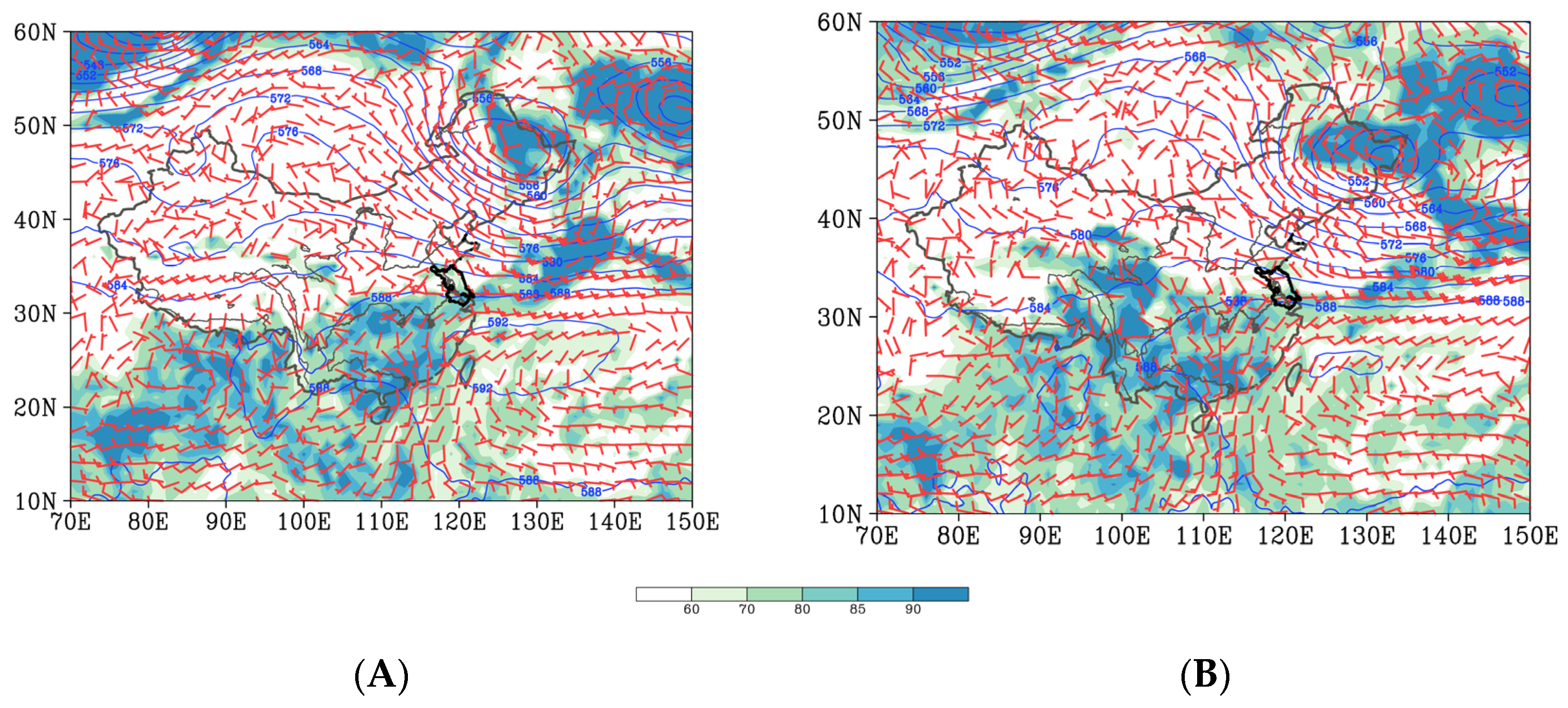
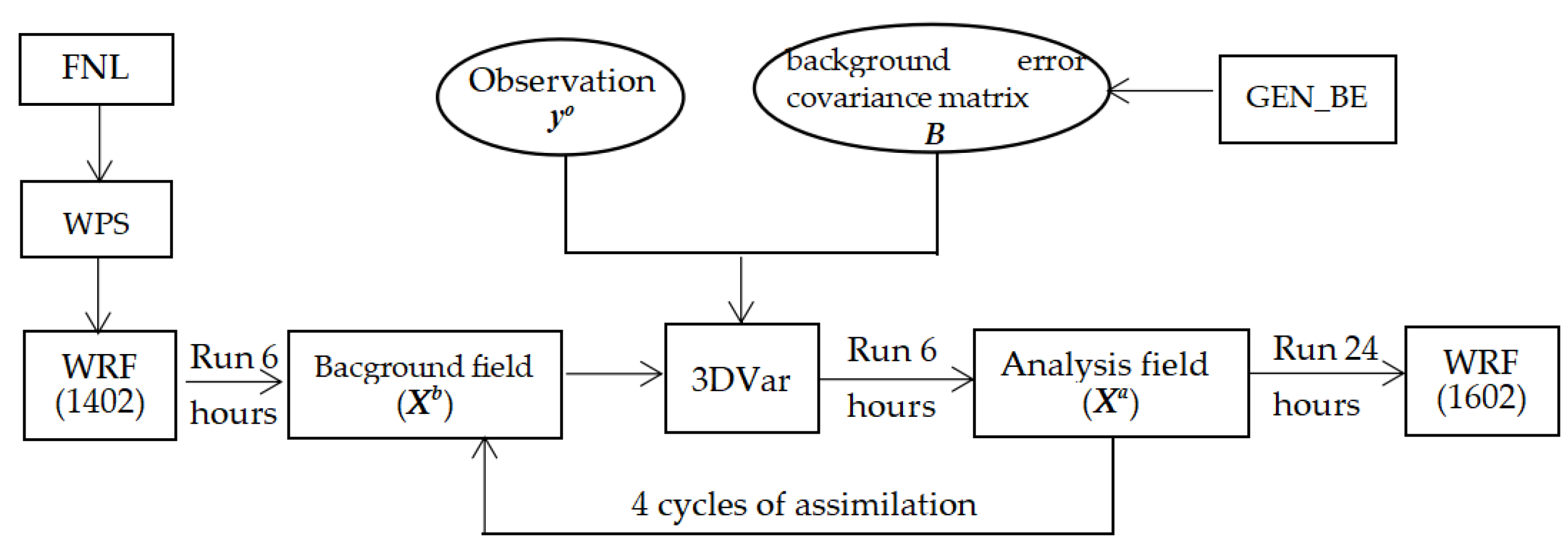
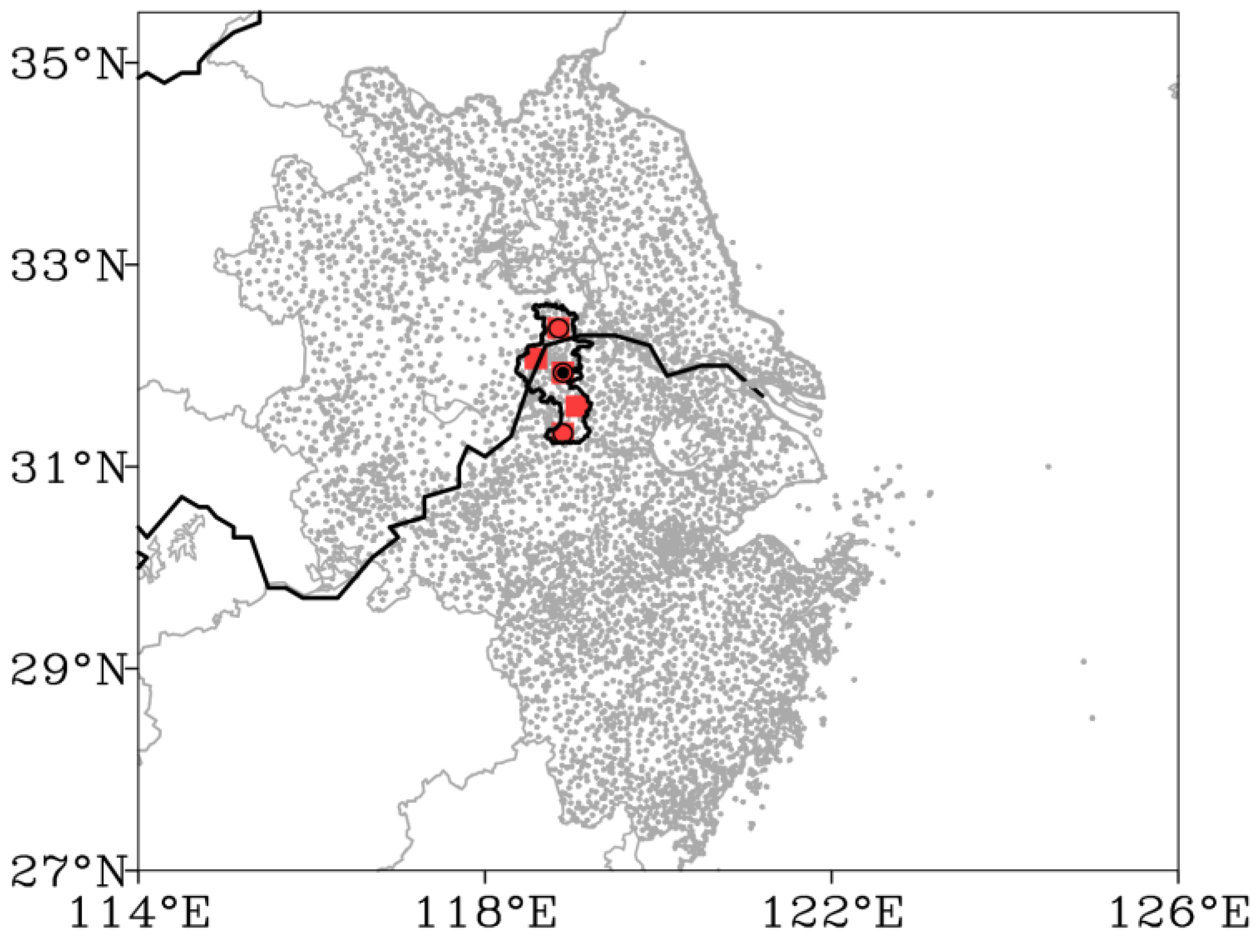
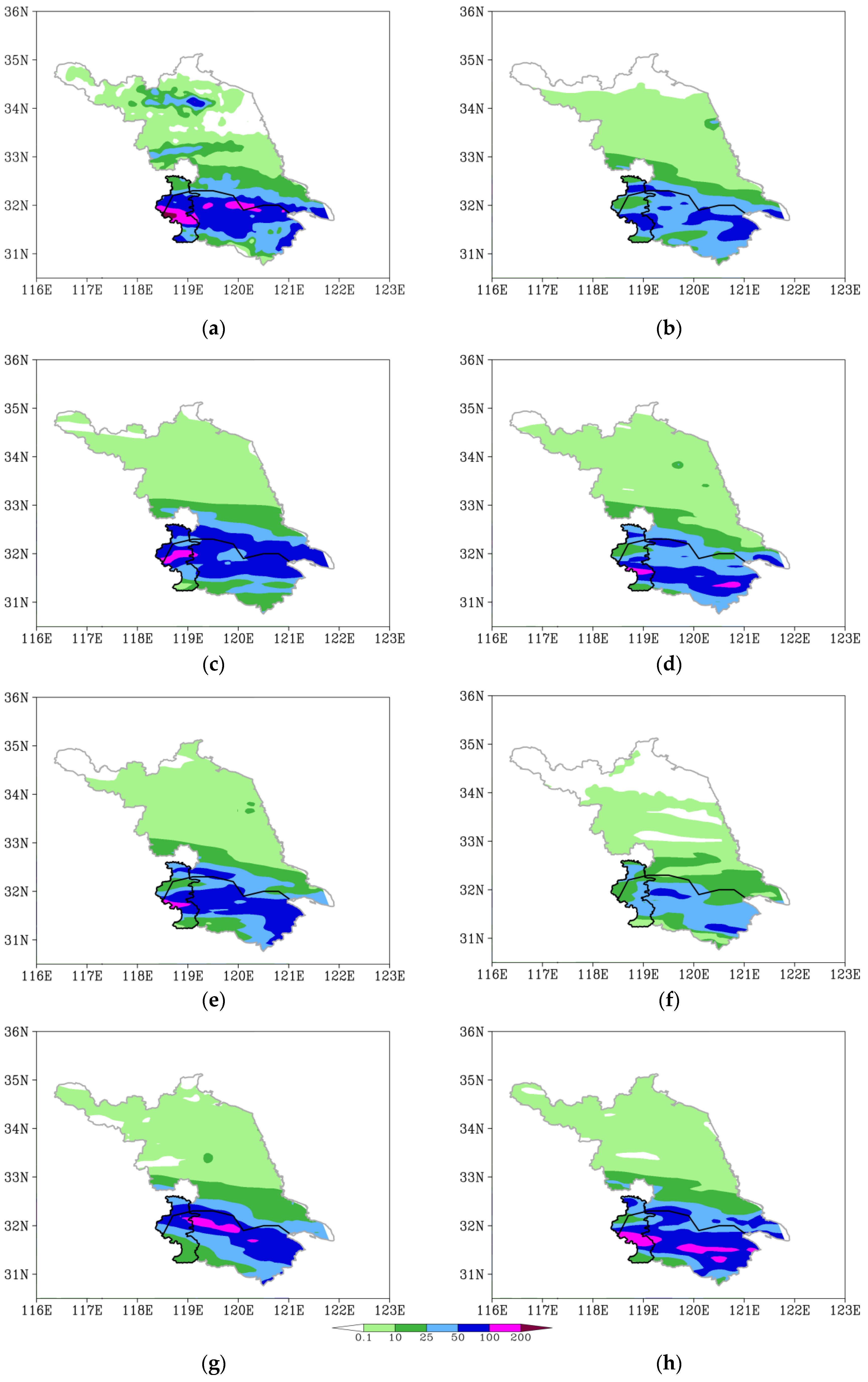
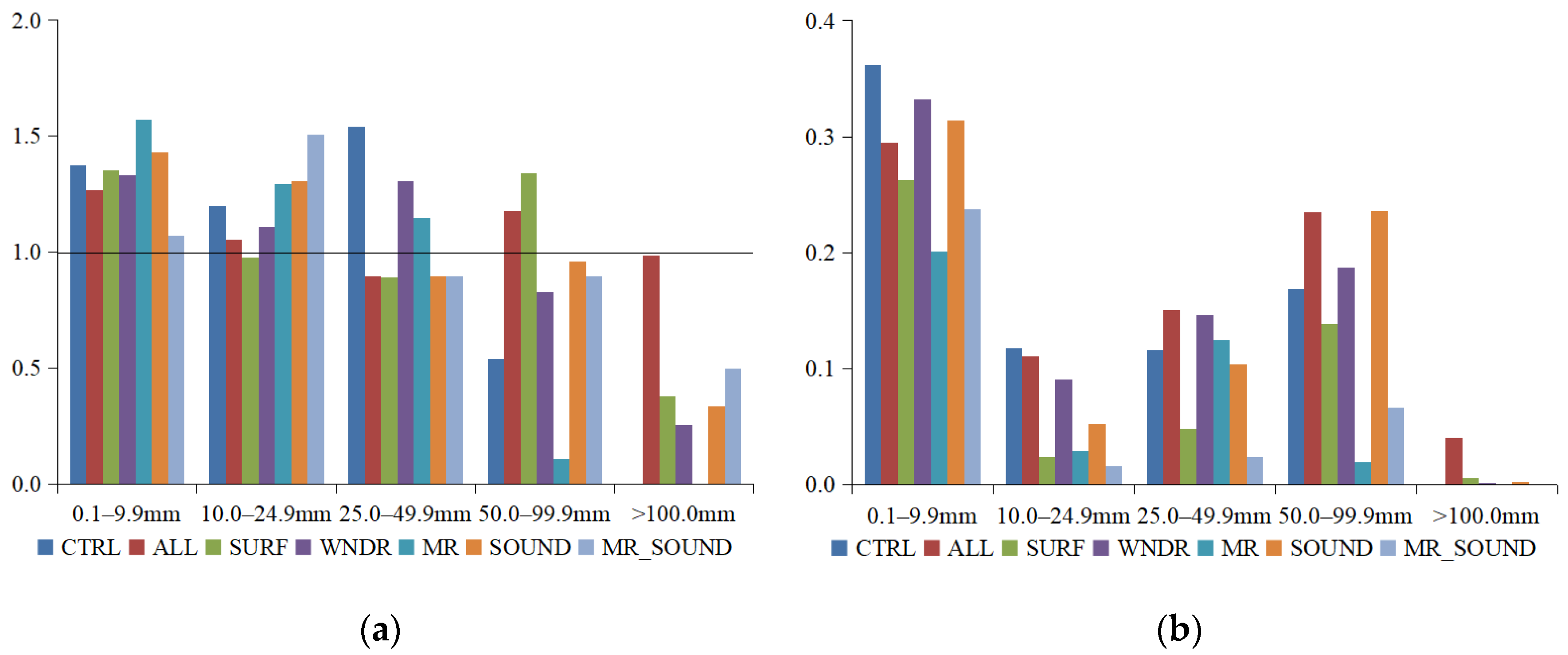
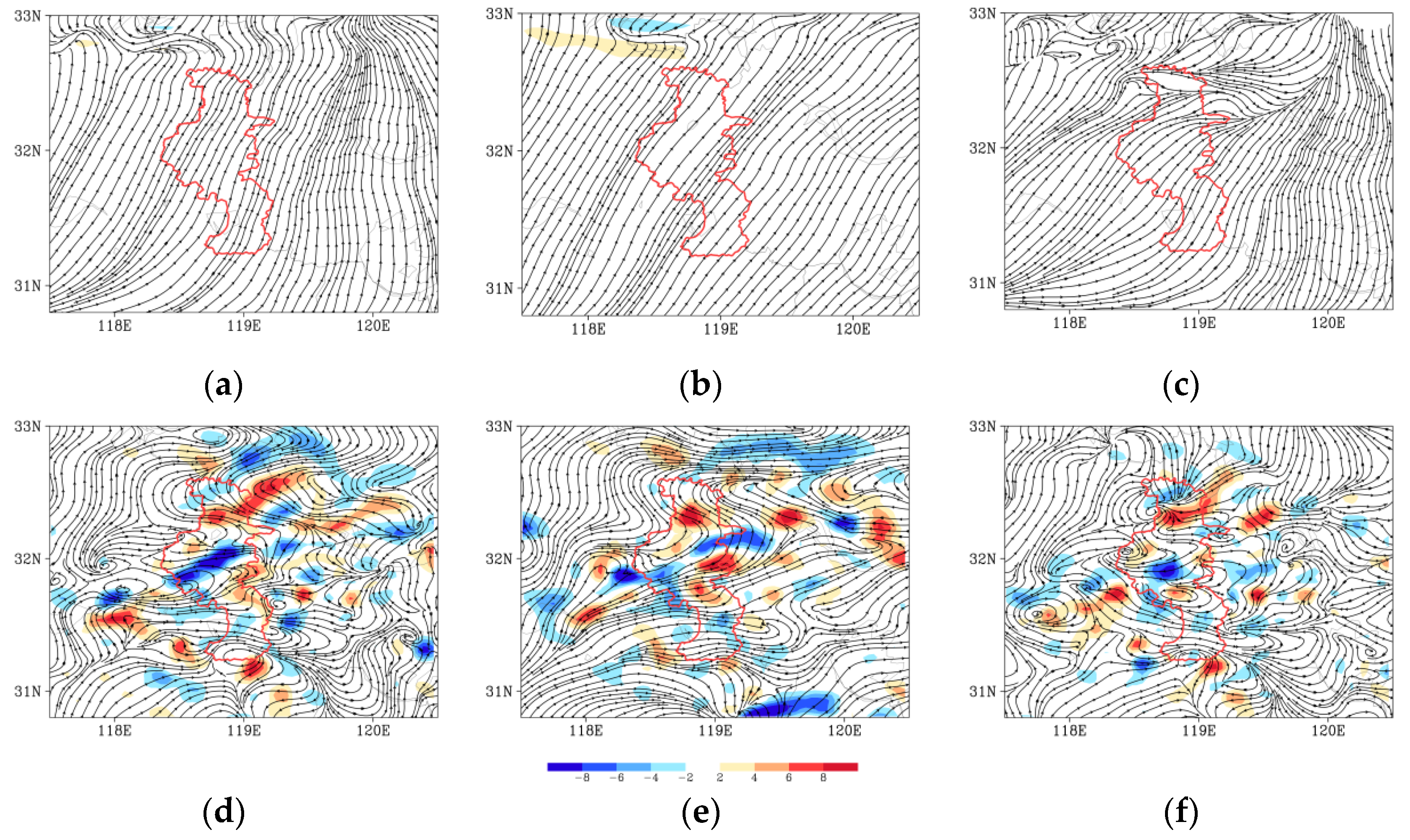
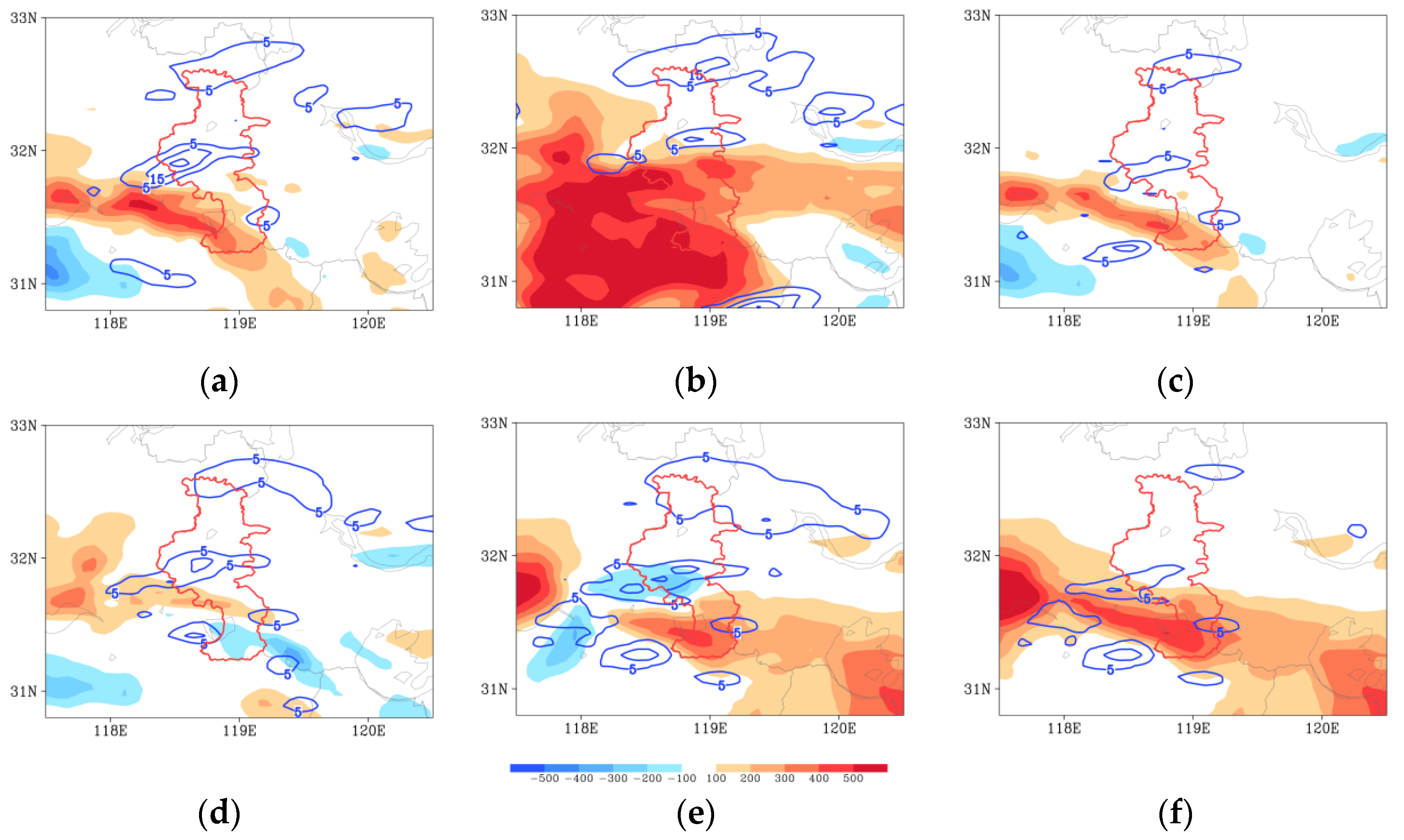
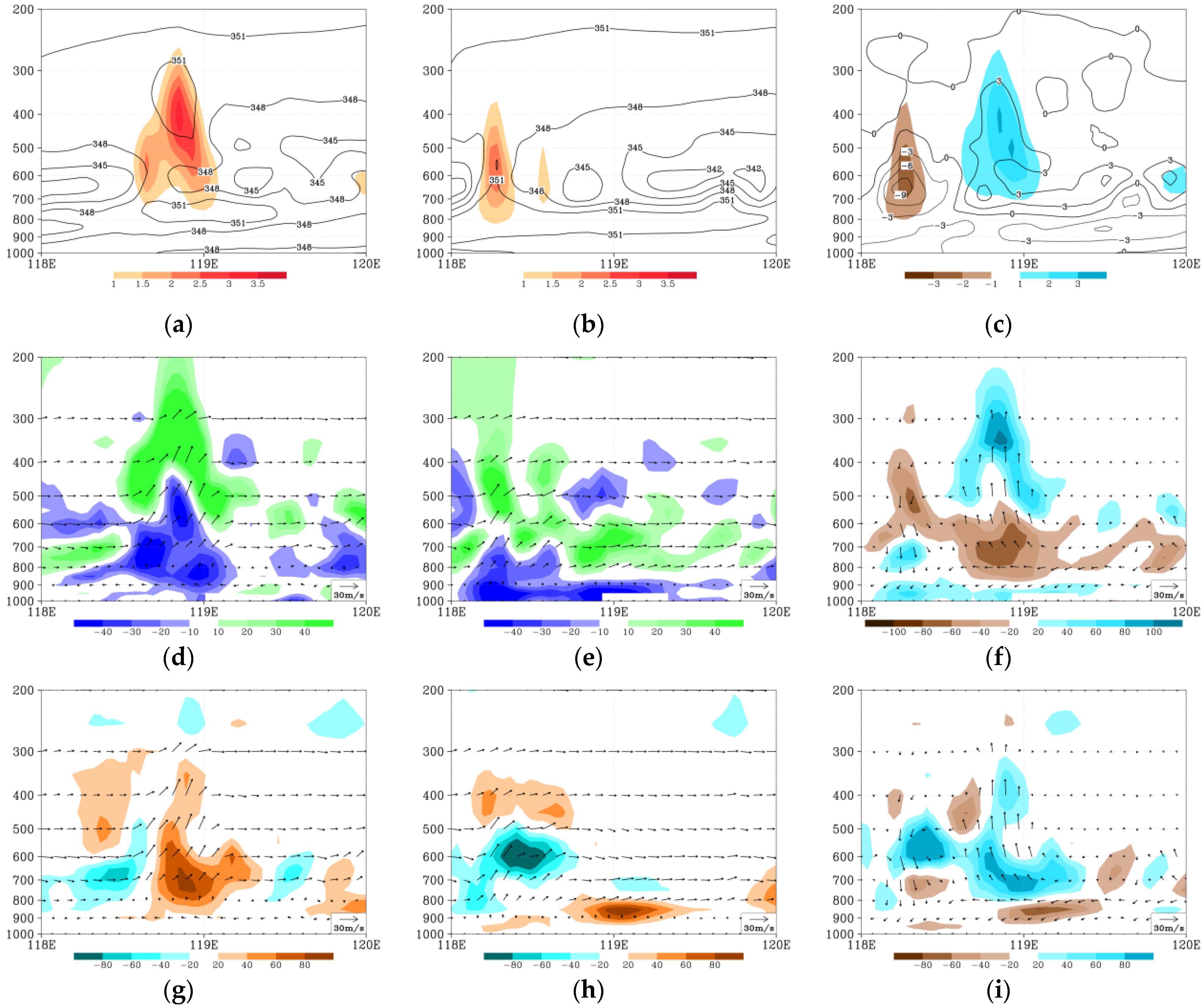
| Parameterized Types | Cumulus Parameterization Scheme |
|---|---|
| Microphysics | New Thompson scheme |
| Cumulus Parameterization | Tiedtke scheme |
| Longwave Radiation | RRTMG scheme |
| Shortwave Radiation | RRTMG shortwave |
| Planetary Boundary layer | Mellor–Yamada–Janjic scheme |
| Surface Layer | Monin–Obukhov scheme |
| Land Surface | Noah Land Surface Model |
| Name | Assimilation Data | Location |
|---|---|---|
| CTRL | - | - |
| ALL | surface observation (air temperature, air pressure, relative humidity, wind direction and wind speed), 5 wind profiler radars (wind direction and wind speed), 3 microwave radiometers (air temperature and humidity) and 1 radiosonde sounding (air temperature, air pressure, relative humidity, wind direction and wind speed) | in East China and 5 stations in Nanjing |
| SURF | conventional surface observation | East China |
| WNDR | 5 wind profiler radars | Luhe, Nanjing, Pukou, Lishui, Gaochun |
| MR | 3 microwave radiometers | Luhe, Nanjing, Pukou |
| SOUND | 1 radiosonde sounding | Nanjing |
| MR_SOUND | 3 microwave radiometers and 1 sounding | Luhe, Nanjing, Pukou |
Disclaimer/Publisher’s Note: The statements, opinions and data contained in all publications are solely those of the individual author(s) and contributor(s) and not of MDPI and/or the editor(s). MDPI and/or the editor(s) disclaim responsibility for any injury to people or property resulting from any ideas, methods, instructions or products referred to in the content. |
© 2023 by the authors. Licensee MDPI, Basel, Switzerland. This article is an open access article distributed under the terms and conditions of the Creative Commons Attribution (CC BY) license (https://creativecommons.org/licenses/by/4.0/).
Share and Cite
Zhao, H.; Shu, Y.; Mao, Y.; Liu, Y.; Yu, K. The Assimilation Effect of Multi-New Types Observation Data in the Forecasts of Meiyu-Front Rainstorm. Atmosphere 2023, 14, 693. https://doi.org/10.3390/atmos14040693
Zhao H, Shu Y, Mao Y, Liu Y, Yu K. The Assimilation Effect of Multi-New Types Observation Data in the Forecasts of Meiyu-Front Rainstorm. Atmosphere. 2023; 14(4):693. https://doi.org/10.3390/atmos14040693
Chicago/Turabian StyleZhao, Hong, Yu Shu, Yuqing Mao, Yin Liu, and Kun Yu. 2023. "The Assimilation Effect of Multi-New Types Observation Data in the Forecasts of Meiyu-Front Rainstorm" Atmosphere 14, no. 4: 693. https://doi.org/10.3390/atmos14040693
APA StyleZhao, H., Shu, Y., Mao, Y., Liu, Y., & Yu, K. (2023). The Assimilation Effect of Multi-New Types Observation Data in the Forecasts of Meiyu-Front Rainstorm. Atmosphere, 14(4), 693. https://doi.org/10.3390/atmos14040693








